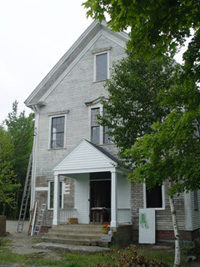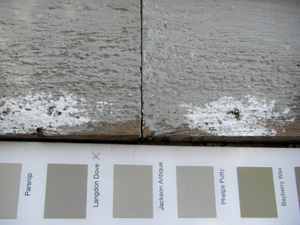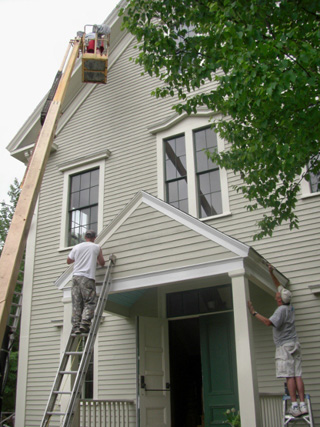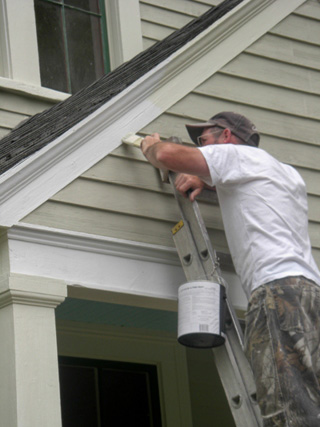Round Pond Schoolhouse Association
1426 State Route 32 Round Pond, ME 04564
1426 State Route 32 Round Pond, ME 04564
The first repair necessary, even before ownership of the schoolhouse, was halting the South roofline rot and leak, and weatherizing the building. Mike Alderson, timber framer and restorer, set up scaffolding and peeled off the rotten remnants of original wooden gutter and trim board, married ends to the exposed rotten rafters, replaced the trim board, restored as possible and hand carved matching crown molding, and replaced the bed molding. An aluminum gutter of appropriate profile was attached. The drain on the S.E. corner was moved to the back corner so that water could spill down the hill and not lead into the cellar. The asphalt roof edge (1976) was found to be crumbling and fell short of the proper overhang. However, it was judged adequate until time for total reroofing.

While the scaffolding was still in place, the disintegrating flashing over the S. windows was replaced, and the curling clapboards with their protruding nails were tightened down over the upper 1/2 of the S side.
The windows, which were badly broken, were covered with plastic sheeting or plywood. Two corbels were missing. Carpenters' Boat Shop offered to make replacements using our found pieces for a pattern.
In the spring, the front porch was repaired in preparation for some highly visible painting. We wanted the community to begin to notice the schoolhouse and think of it as other than a derelict. The original front porch ran across the full front of the building with 3 entry doors and a central gable. Sometime during the later years as a school the lateral wings were cut off, bits of railing were slapped onto the sides of the remaining gable porch and the side doors were converted to windows. From an old photograph with retired teacher Mrs.Tibbetts standing to the side of the truncated porch, it would appear that it was cut down by the 1940's. Further repairs by Masters Machine had been slap-dash.
Railings and posts were repaired by Mike Alderson, and the old badly damaged doors were removed for stripping and repairs. The remains of a matching door was found mired in the mud and oil in the cellar and was used to cut patches and tenon connections for the front doors. The brass lockset and rocker bar were sent out for locksmith repairs. Enough missing steeple-hinge parts were found in the schoolhouse debris for a set. Also at this time the hanging cellar door was removed for repair.

Matching the original paint. The white blobs are coating over rusty nail heads. It was thought by all we spoke to that the building had once been white, like other buildings in town. It appeared grey 'just because it was old and weathered'. From sanding down the porch area there was no identifiable paint left on the body of the building to tell otherwise, as the weather comes in from the sea onto this side and had done a good job of paint removal. The trim was whitish, and it was definite that the sash was originally 'park green'. The ceiling of the porch was sky blue after sanding off the powdery surface grey and mildew. Old timers say this color was frequently chosen because spiders won't build webs under it. In our case, this seems to be true.

We first painted the porch area white - and it looked awful - too stark and glaring. Next, when sanding down on the S. side, we discovered under the dirty-whitish surface powder definite grey paint. Rubbing it with linseed oil brought out its original putty color - apparently either milk or pogy paint - both used locally at this time, and we understand there is no easy way to differentiate between them. By reading about Victorian exterior paint colors, and with the help of Sally Zimmerman, the paint authority from 'Historic New England', we were advised that 'one of the stony greys' (on the California Historic colors paint chart) for the body, with 'Jewett White' trim, would be the most appropriate for 'an 1885 Italianate public building in a working midcoast town in Maine'. Accordingly, the Board chose 'Jackson Antique' as the best grey tone to both match our paint remnant and compliment the 'park green' sash. California Paints, after a tour of the building by their regional sales rep Dana Morse, offered us their top line of paint, factory mixed, at cost. We used their alkyd linseed oil 'Trouble Shooter' (tinted) for the primer, followed by 2 coats of their '2010' acrylic latex, with Jewett White semigloss for the trim. This color combination looked terrific - and historically accurate.

Ultimately, the sheriff's crew was not able to commit the time to maintain our schedule. We therefore, in 2010, contracted with the Leeman Bros. for proper 'restoration painting' to be done in 2 stages - as finances allowed - first the front and south sides, then the west and north two years later.
We were in line for the Lincoln County Sheriff's crew for free painting, but we wanted to know first hand what to expect in workmanship and difficulties. Therefore, we continued the painting to the level of the top of the first story windows - on the front and S. side. (This could be reached by volunteers without fear or scaffolding.) Clapboards were renailed and tightened down - on damp days to minimize splitting - then sanded to remove all paint possible. Any mildew was sprayed with a chlorox solution. The many electric holes were plugged with corks and sanded, missing and broken clapboards were replaced, window frames and molding were repaired with Bondo and carved patches. Punk wood was brushed with linseed oil, ex. the boards below the snow line, also the window sills, and all the replacement boards in the area of the 1920's fire escape. The original clapboards were generally of excellent quality even after all these years and apparently only one paint job in those 125 years. Replacement boards were poorer quality wood and tended to 'paper chip', pulling their nails up with them. Rusted nail heads were coated with dabs of Hammerite Rust Cap, then everything was primed. Cracks, splits and vertical lines were caulked with 'Alex Plus' 35 year caulk. Then a coat of latex paint applied, leaving the 2nd coat of paint to be applied from the top down when the painting crew arrived. Window frames, however, received 2 coats, both on trim boards and jambs, so the windows wouldn't be painted shut or dripped on later.